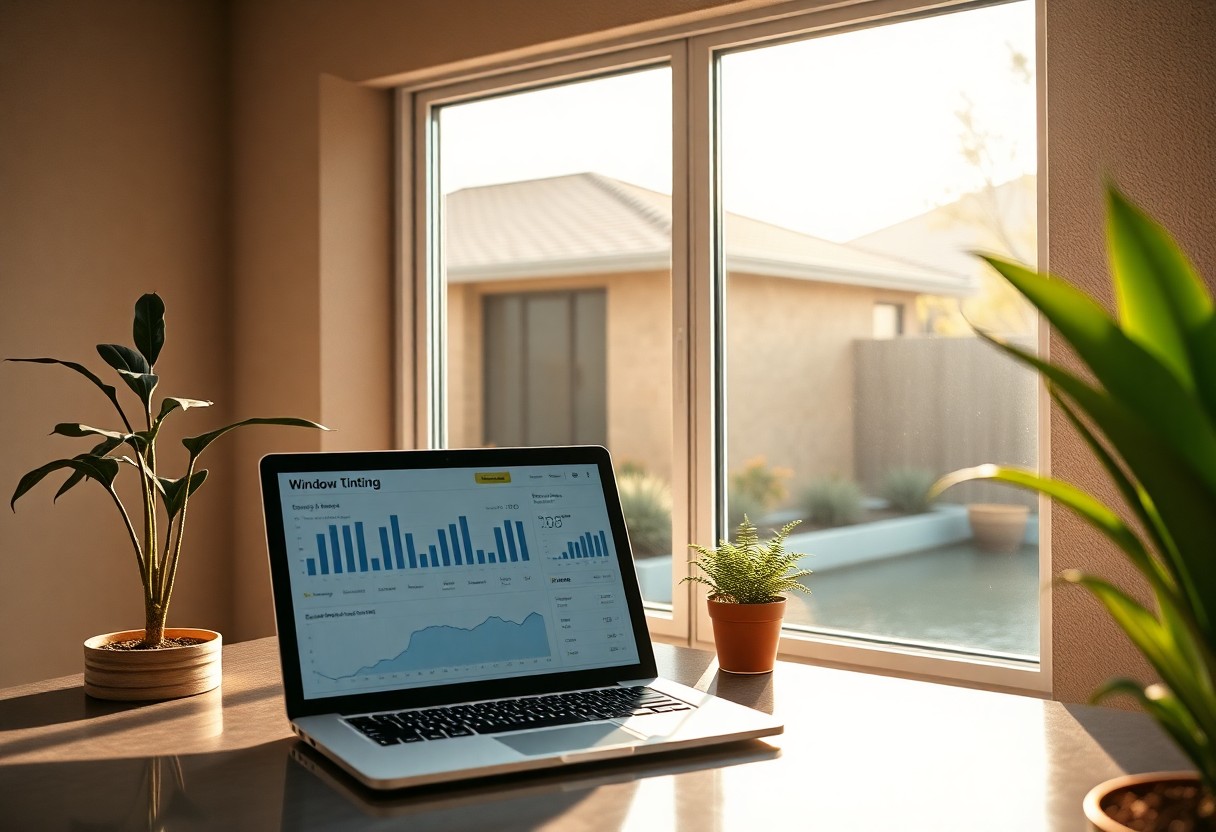You can significantly reduce your energy bills and enhance the comfort of your home with residential window tinting in Aguila. By minimizing heat gain during hot months and improving insulation during cooler seasons, window film helps maintain a stable indoor temperature. This not only prolongs the life of your HVAC system but also creates a more pleasant living environment. Additionally, protective tints can reduce glare and prevent furniture fading, leading to further long-term savings on repairs and replacements. Investing in residential window tinting is a practical choice for smart homeowners looking to save over time.

Understanding Residential Window Tinting
Residential window tinting involves applying a thin film to the glass surface in your home, enhancing energy efficiency while providing privacy and aesthetic appeal. This treatment helps to filter sunlight, reduce heat, and protect interior furnishings from UV damage, leading to long-term cost savings and improved comfort.
What is Window Tinting?
Window tinting is a protective film applied directly to your window glass, transforming how sunlight interacts with your living space. By minimizing glare and controlling heat, window tinting creates a more comfortable environment and helps lower your energy costs, optimizing your home’s overall efficiency.
Types of Window Tints
There are various types of window tints available, each offering different benefits suited to your specific needs. Options like reflective, dyed, and ceramic films cater to diverse requirements, such as heat rejection or privacy. Understanding these variations can help you make informed decisions regarding your residential window tinting.
| Type of Tint | Benefits |
|---|---|
| Reflective | Reduces heat gain and glare |
| Dyed | Enhances privacy and blocks UV rays |
| Ceramic | Provides superior heat rejection without reflection |
| Safety and Security | Holds glass together and increases break resistance |
| Decorative | Enhances aesthetic appeal while maintaining functionality |
- Assume that each type of window tint serves a unique purpose tailored to different homeowner preferences and requirements.
The types of window tints vary significantly in performance and application. For instance, reflective tints are excellent for energy savings by reflecting heat away, while dyed tints offer privacy benefits at a lower cost. Ceramic tints are gaining popularity for their ability to block UV rays without altering the view. Safety and security tints provide additional protection against accidents or break-ins. Exploring these options allows you to choose the best fit for your home and lifestyle.
| Type of Tint | Key Characteristics |
|---|---|
| Reflective | Mirror-like surface, high glare reduction |
| Dyed | Color saturation, affordable option |
| Ceramic | Non-metallic, excellent UV and infrared protection |
| Safety and Security | Thicker film, increases shatter resistance |
| Decorative | Variety of designs, versatile for interior applications |
- Assume that educational understanding of these tint options can lead to better choices for energy savings and comfort in your home.
Benefits of Window Tinting
Window tinting provides a multitude of advantages that go beyond aesthetics. These benefits include improved energy efficiency, UV protection, increased privacy, and enhanced comfort within your home. By incorporating tinted windows, you create a more pleasant environment and significantly reduce long-term costs associated with heating and cooling.
Energy Efficiency
By installing window tint, you can improve your home’s energy efficiency. This investment reduces heat gain during the summer and heat loss during the winter, allowing your HVAC system to function more effectively. As a result, you may see a decrease in your energy bills by up to 30%, making it an economically savvy decision.
UV Protection
Window tint offers significant protection against harmful UV rays, blocking up to 99% of these rays from entering your home. This not only safeguards your skin but also preserves your furniture, carpets, and artwork from fading and damage, extending their lifespan and keeping your home looking vibrant.
In Aguila, the sun’s intensity can lead to considerable UV exposure, with statistics indicating that prolonged exposure can lead to skin cancer and premature aging. With window tinting acting as a barrier, you can enjoy natural light without the health risks. This protective feature is especially beneficial for homes with children or pets, providing peace of mind while you enjoy your living space. Plus, reducing UV exposure not only conserves your health but also minimizes replacement costs for sun-damaged items, making it a smart long-term investment.
Financial Implications
Initial Investment vs. Long-Term Savings
While the upfront cost of window tinting may seem significant, the long-term savings on energy bills can be substantial. By reducing heat gain in your home, you can lower your air conditioning expenses by up to 30%, translating to hundreds of dollars annually. Over time, these savings often surpass the initial investment, making window tinting a financially savvy choice for homeowners looking to optimize their energy efficiency.
Potential Tax Incentives
Tax incentives can further enhance the financial benefits of residential window tinting. Depending on your location and the type of film applied, you may qualify for deductions or credits that offset a portion of your initial expenses. This not only reduces your financial burden but can also accelerate the return on your investment.
In some cases, energy-efficient window films are recognized under federal and state energy conservation programs. For example, a homeowner may receive a tax credit of up to 10% of the costs associated with energy-efficient improvements, including window tinting. Additionally, some utility companies offer rebates for homeowners who implement energy-saving measures, creating further opportunities for cost recovery. It’s advisable to check with local authorities and tax professionals to explore available incentives specific to your area. Evaluating these potential savings can significantly impact your decision-making process regarding window tinting.
Case Studies from Aguila Residents
- Homeowner A: Saved 30% on annual energy bills after installing window tint; total savings of $450 over three years.
- Homeowner B: Reduced indoor temperature by 10°F during summer, enhancing comfort and cutting cooling costs by 25%.
- Homeowner C: Reported a 40% decrease in glare and UV exposure, preventing over $200 in furniture fading costs per year.
- Homeowner D: Increased property value by 5% post tint installation, translating to an extra $10,000 in potential resale value.
Real-Life Savings Examples
These case studies exemplify how window tinting can translate directly into real savings. Homeowners who installed tinting saw reductions in energy bills ranging from 25% to 40%, with the average annual savings estimated at $450. Such financial benefits, coupled with enhanced home comfort and UV protection, make window tinting a smart long-term investment.
Customer Testimonials
Residents in Aguila have shared positive experiences regarding window tinting’s impact on their homes. One homeowner noted, “The difference in temperature during summer is remarkable; my bills are lower, and my house feels cooler.” Another stated, “Not only does the tint add privacy, but I also appreciate the energy savings and the protection from UV damage.”
Customer testimonials highlight the tangible benefits Aguila residents experience with window tinting. Many report significant decreases in energy costs and increased comfort levels within their homes. The positive feedback underscores satisfaction not only with the financial savings but also with the improved living environment and aesthetic appeal. These insights are vital for anyone considering window tinting as a viable and beneficial home improvement solution.
Choosing the Right Window Tint
Selecting the appropriate window tint for your home in Aguila requires careful consideration of various options, ensuring that you choose a product that meets your needs effectively while maximizing long-term savings. The right tint can significantly reduce glare, enhance privacy, and improve energy efficiency, all contributing to a more comfortable living environment.
Factors to Consider
When choosing window tint, consider factors such as solar heat gain, UV protection, tint darkness, and local regulations. Each of these can influence how effective the tint will be in your specific environment.
- Solar heat gain and loss
- UV protection level
- Desired darkness of tint
- Compliance with local laws
Recognizing the implications of these factors will guide you toward making a well-informed choice suited to your home’s specific needs.
Professional Installation vs. DIY
Choosing between professional installation and DIY window tinting is an important decision that can affect the outcome. While DIY options might save you money upfront, professional installation ensures expert application, reducing the risk of bubbles and misalignment significantly.
Professionals bring experience, quality tools, and often a warranty on their work, which can save you from costly mistakes. DIY projects can result in uneven films or improper adhesive application, leading to more frequent replacements. If you value durability and a flawless finish, investing in professional installation is typically the smarter route for long-term satisfaction with your window tint.
Maintenance of Tinted Windows
Regular maintenance of tinted windows ensures longevity and efficiency. You should clean your windows with a soft cloth and a mild soap solution, avoiding ammonia-based cleaners to preserve the tint. Inspect for any bubbles or scratches periodically to address potential issues before they worsen.
Care and Upkeep
To keep your tinted windows looking their best, use a gentle touch when cleaning, opting for soft cloths to avoid scratching the surface. Avoid using harsh chemicals, as they can damage the film. A regular cleaning schedule helps to maintain clarity and structural integrity, allowing you to enjoy the benefits of your investment fully.
Longevity of Window Tint
Typically, quality window tints can last anywhere from 5 to 15 years, depending on the material and installation quality. Proper care can significantly extend this lifespan, ensuring that you get the most out of your investment while also continuing to enjoy the aesthetic and energy-saving benefits.
For instance, high-grade ceramic window tints, while more expensive initially, can endure up to 15 years with minimal fading or degradation. In contrast, cheaper films may begin to show signs of wear in as little as 5 years. By opting for reputable brands and professional installation, you can enhance the durability of your window tint, making it a sound long-term investment.
Final Words
On the whole, investing in residential window tinting in Aguila can lead to significant long-term savings for you. By reducing energy costs and minimizing wear on your HVAC system, tinted windows enhance your home’s efficiency. Additionally, they provide protection for your furnishings from harmful UV rays, prolonging their lifespan. Overall, these benefits not only translate to lower utility bills but also contribute to a more comfortable living environment, making window tinting a wise financial decision for your home.





